The Adult and Pediatric Hemoconcentrators Market is estimated to be valued at USD 12.5 billion in 2025 and is projected to reach USD 16.9 billion by 2035, registering a compound annual growth rate (CAGR) of 3.0% over the forecast period.
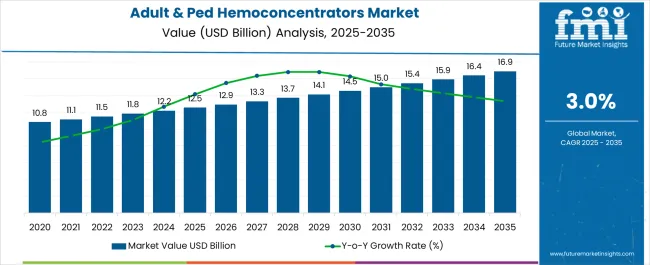
| Metric | Value |
|---|---|
| Adult and Pediatric Hemoconcentrators Market Estimated Value in (2025 E) | USD 12.5 billion |
| Adult and Pediatric Hemoconcentrators Market Forecast Value in (2035 F) | USD 16.9 billion |
| Forecast CAGR (2025 to 2035) | 3.0% |
The adult and pediatric hemoconcentrators market is witnessing steady growth, supported by the increasing number of cardiovascular procedures and the rising prevalence of chronic kidney diseases requiring extracorporeal circulation support. Growing adoption of hemoconcentrators in both adult and pediatric surgeries is being driven by their ability to effectively manage hemodilution, reduce fluid overload, and improve patient recovery outcomes. Healthcare systems are increasingly prioritizing advanced blood management solutions to lower complications and reduce dependence on donor blood, contributing to higher adoption rates.
Technological advancements in membrane design and material science are enhancing efficiency and safety, further boosting clinical acceptance. Rising healthcare expenditures, expanding access to surgical care, and the availability of portable devices are facilitating widespread use across hospitals and specialty centers.
With increasing demand for minimally invasive procedures and improved perioperative care, hemoconcentrators are expected to remain integral in extracorporeal circulation management As awareness of patient safety and cost optimization grows globally, the market is anticipated to achieve sustained expansion over the coming years.
The adult and pediatric hemoconcentrators market is segmented by product type, filtration method, material, application, end-user, and geographic regions. By product type, adult and pediatric hemoconcentrators market is divided into Portable Hemoconcentrators and Stationary Hemoconcentrators. In terms of filtration method, adult and pediatric hemoconcentrators market is classified into Ultrafiltration, Centrifugal Filtration, and Membrane Filtration. Based on material, adult and pediatric hemoconcentrators market is segmented into Polymer-based Hemoconcentrators, Polycarbonate Hemoconcentrators, and Glass Hemoconcentrators. By application, adult and pediatric hemoconcentrators market is segmented into Cardiopulmonary Bypass, Dialysis, Plasmapheresis, and Therapeutic Plasma Exchange. By end-user, adult and pediatric hemoconcentrators market is segmented into Hospitals, Ambulatory Surgical Centers, Home Healthcare Settings, and Dialysis Centers. Regionally, the adult and pediatric hemoconcentrators industry is classified into North America, Latin America, Western Europe, Eastern Europe, Balkan & Baltic Countries, Russia & Belarus, Central Asia, East Asia, South Asia & Pacific, and the Middle East & Africa.
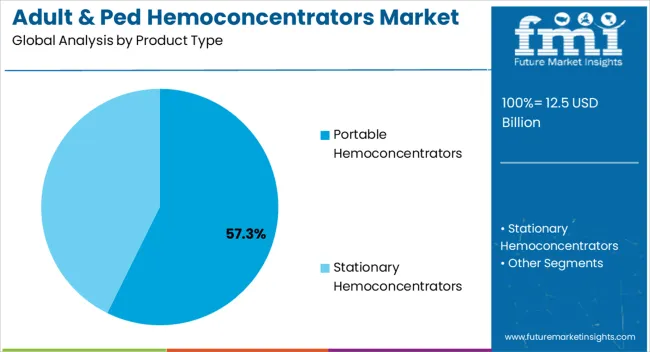
The portable hemoconcentrators segment is projected to hold 57.3% of the adult and pediatric hemoconcentrators market revenue share in 2025, making it the leading product type. This dominance is being driven by their adaptability, ease of handling, and suitability for a wide range of surgical environments. Their compact design allows for efficient integration into both adult and pediatric operating rooms, enabling improved mobility and reducing space requirements in critical care settings.
The growing preference for devices that enhance workflow efficiency and patient safety is also contributing to their adoption. Portable hemoconcentrators reduce the need for complex infrastructure, making them cost-effective solutions for both high-resource and resource-limited healthcare facilities. Clinical teams prefer these devices because they simplify setup and operation while maintaining high levels of performance and accuracy in managing blood concentration.
The ability to support diverse surgical procedures with minimal logistical challenges has further reinforced their market share As demand for flexible and efficient extracorporeal blood management grows, portable systems are expected to remain the dominant product choice.
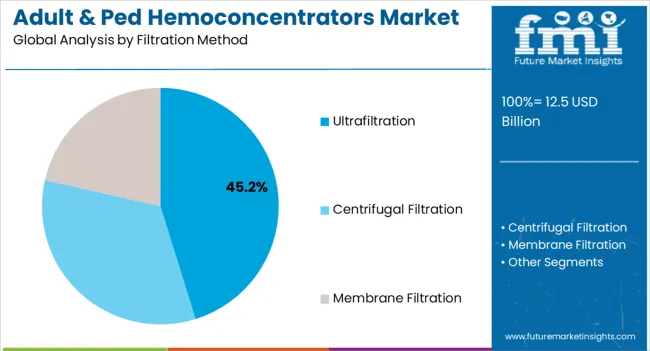
The ultrafiltration segment is anticipated to account for 45.2% of the adult and pediatric hemoconcentrators market revenue share in 2025, positioning it as the leading filtration method. This leadership is being supported by the high efficiency of ultrafiltration in removing excess plasma water, electrolytes, and low molecular weight solutes while preserving vital blood components. Clinical effectiveness in achieving fluid balance without compromising patient safety has enhanced its acceptance across surgical and critical care settings.
The ability of ultrafiltration to provide precise control over hemoconcentration levels is enabling improved outcomes in both adult and pediatric patients. Increasing integration of advanced polymer membranes and improved surface treatments has enhanced the durability and biocompatibility of ultrafiltration devices, further supporting their use.
Hospitals are adopting this method due to its cost-effectiveness, as it reduces the reliance on blood transfusions and associated risks With rising demand for effective fluid management solutions in cardiac and extracorporeal procedures, ultrafiltration is expected to maintain its strong position in the market.
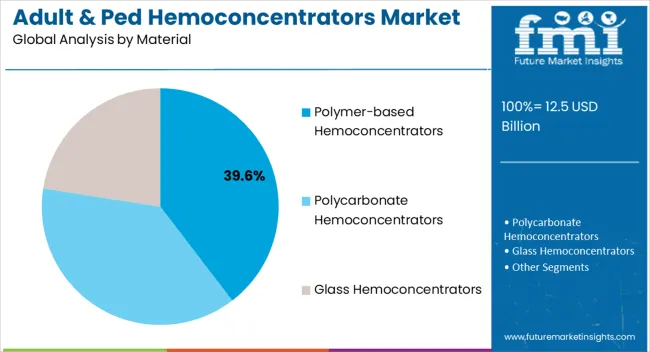
The polymer-based hemoconcentrators segment is expected to capture 39.6% of the adult and pediatric hemoconcentrators market revenue share in 2025, making it the leading material category. This dominance is being reinforced by the advantages of polymer materials, including lightweight structure, high durability, and superior biocompatibility. The ability of polymer-based devices to withstand prolonged use in extracorporeal circulation systems without compromising performance has supported their widespread adoption.
Manufacturers are increasingly using advanced polymer composites that allow for greater design flexibility and improved membrane performance, which enhances both efficiency and patient safety. Cost-effectiveness in production and scalability in mass manufacturing have further strengthened their market presence.
The growing demand for materials that minimize adverse reactions and improve patient outcomes is aligning with the benefits provided by polymer-based hemoconcentrators As healthcare systems focus on affordable and reliable blood management solutions, polymer-based devices are expected to continue dominating the material segment, ensuring strong growth potential over the forecast period.
Sales of adult and pediatric hemoconcentrators are expected to rise as perfusionists and surgeons are increasingly relying on hemoconcentrators to maintain higher hematocrit levels during cardiopulmonary surgery. In addition to this, demand for adult and pediatric hemoconcentrators is rising on account of heart diseases becoming more common over the world.
The increasing frequency of cardiovascular disorders in low-income nations has prompted an emphasis on cardiac care, which is projected to contribute to the growth of the adult and pediatric hemoconcentrators market share.
The report sheds light on the factors improving the sales of adult and pediatric hemoconcentrators and, in turn, the opportunities for the market players. However, the adult and pediatric hemoconcentrators market also face some challenges, limiting theadult and pediatric hemoconcentrators market share from reaching its potential.
Some of the key adult and pediatric hemoconcentrators maret trends promoting the demand for adult and pediatric hemoconcentrators include growing public knowledge of the virus's harmful effects on organs such as the lungs and heart, which may aid a faster industry recovery from the pandemic in the near future.
The growing number of cardiac bypass surgery patients and the increased need for technologically enhanced fluid management products are driving the global adult and pediatric hemoconcentrators market.
Other factors projected to enhance market expansion include various government efforts, an aging population, and more research and development activities. On the other hand, the availability of hemoconcentration alternatives, the numerous difficulties connected with hemoconcentration, and a lack of knowledge are all crucial issues that could slow the global market's growth.
Surgeons have preferred the hemoconcentration method for controlling hemodilution during cardiopulmonary surgery. This process also helps maintain higher hematocrit levels and reduces the need for additional blood products during and after bypass surgery. The usage of hemoconcentration during cardiac bypass surgery is increasing continuously, and so is the demand for adult and pediatric hemoconcentrators.
The hemoconcentrators help decrease the risk after post-operative bleeding and reduce the need for homologous blood and blood products, leading to a rise indemand for adult and pediatric hemoconcentrators. The hemoconcentrators come with different sized and glycerine-free polysulfone membranes for excellent biocompatibility. It also helps to easy insertion and maintain higher hematocrit and fluid levels.
According to the WHO, approximately 17.3 million people died from CVDs in 2008 globally, and the number is expected to increase by 23.6 million by 2035. Globally, with the increasing number of patients with cardiac diseases, demand a cost-effective method of processing hemodiluted blood.
The aging population is increasing, which results in the sales of adult and pediatric hemoconcentrators also rising.
An increasing number of patients with cardiac bypass surgery, rising demand for technologically advanced fluid management products, increasing research and development activities, government initiatives, and a growing aging population are some of the factors that drive the sales of adult and pediatric hemoconcentrators.
However, the availability of substitutes for hemoconcentrators acts as an inhibitor for this market, which might limit the sales of adult and pediatric hemoconcentrators.
The global adult and pediatric hemoconcentrators market are expected to register a healthy CAGR for the forecast period with a stable demand for adult and pediatric hemoconcentrators. Depending on geographic regions, the global adult and pediatric hemoconcentrators market are segmented into seven key regions: North America, South America, Eastern Europe, Western Europe, Asia Pacific excluding Japan, Japan and Middle East & Africa.
North America, followed by Europe, dominates the sales of adult and pediatric hemoconcentrators due to the increasing number of patients with cardiac bypass, growing aging population, developed healthcare infrastructure and growing demand for adult and pediatric hemoconcentrators in these regions.
Asia Pacific is the fastest emerging market with high sales of adult and pediatric hemoconcentrators due to the growing patient population with cardiac diseases, increasing awareness about advanced fluid management products available in the market, developing healthcare infrastructure and rising government spending in the healthcare industry in this region.
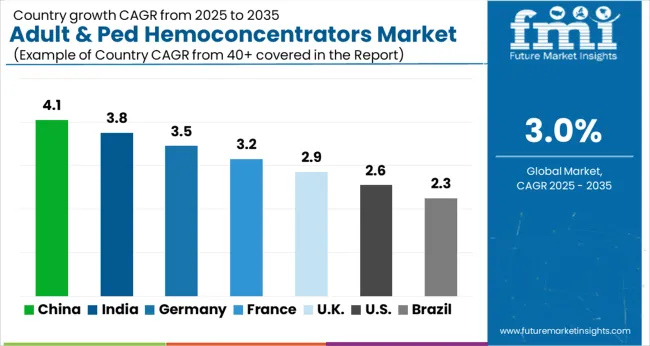
| Country | CAGR |
|---|---|
| China | 7.4% |
| India | 6.9% |
| Germany | 6.3% |
| France | 5.8% |
| UK | 5.2% |
| USA | 4.7% |
| Brazil | 4.1% |
The Adult and Pediatric Hemoconcentrators Market is expected to register a CAGR of 3.0% during the forecast period, exhibiting varied country level momentum. China leads with the highest CAGR of 7.4%, followed by India at 6.9%. Developed markets such as Germany, France, and the UK continue to expand steadily, while the USA is likely to grow at consistent rates. Brazil posts the lowest CAGR at 2.3%, yet still underscores a broadly positive trajectory for the global Adult and Pediatric Hemoconcentrators Market. In 2024, Germany held a dominant revenue in the Western Europe market and is expected to grow with a CAGR of 3.5%. The USA Adult and Pediatric Hemoconcentrators Market is estimated to be valued at USD 4.3 billion in 2025 and is anticipated to reach a valuation of USD 5.6 billion by 2035. Sales are projected to rise at a CAGR of 2.6% over the forecast period between 2025 and 2035. While Japan and South Korea markets are estimated to be valued at USD 566.2 million and USD 369.9 million respectively in 2025.
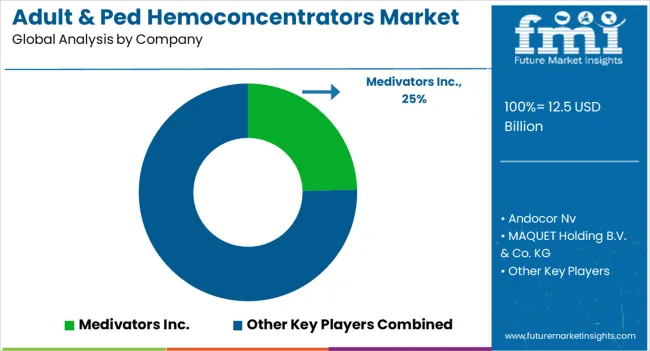
| Item | Value |
|---|---|
| Quantitative Units | USD 12.5 Billion |
| Product Type | Portable Hemoconcentrators and Stationary Hemoconcentrators |
| Filtration Method | Ultrafiltration, Centrifugal Filtration, and Membrane Filtration |
| Material | Polymer-based Hemoconcentrators, Polycarbonate Hemoconcentrators, and Glass Hemoconcentrators |
| Application | Cardiopulmonary Bypass, Dialysis, Plasmapheresis, and Therapeutic Plasma Exchange |
| End-User | Hospitals, Ambulatory Surgical Centers, Home Healthcare Settings, and Dialysis Centers |
| Regions Covered | North America, Europe, Asia-Pacific, Latin America, Middle East & Africa |
| Country Covered | United States, Canada, Germany, France, United Kingdom, China, Japan, India, Brazil, South Africa |
| Key Companies Profiled | Medivators Inc., Andocor Nv, MAQUET Holding B.V. & Co. KG, Terumo Cardiovascular Systems Corporation, and Sorin Group |
The global adult and pediatric hemoconcentrators market is estimated to be valued at USD 12.5 billion in 2025.
The market size for the adult and pediatric hemoconcentrators market is projected to reach USD 16.9 billion by 2035.
The adult and pediatric hemoconcentrators market is expected to grow at a 3.0% CAGR between 2025 and 2035.
The key product types in adult and pediatric hemoconcentrators market are portable hemoconcentrators and stationary hemoconcentrators.
In terms of filtration method, ultrafiltration segment to command 45.2% share in the adult and pediatric hemoconcentrators market in 2025.






Our Research Products

The "Full Research Suite" delivers actionable market intel, deep dives on markets or technologies, so clients act faster, cut risk, and unlock growth.

The Leaderboard benchmarks and ranks top vendors, classifying them as Established Leaders, Leading Challengers, or Disruptors & Challengers.

Locates where complements amplify value and substitutes erode it, forecasting net impact by horizon

We deliver granular, decision-grade intel: market sizing, 5-year forecasts, pricing, adoption, usage, revenue, and operational KPIs—plus competitor tracking, regulation, and value chains—across 60 countries broadly.

Spot the shifts before they hit your P&L. We track inflection points, adoption curves, pricing moves, and ecosystem plays to show where demand is heading, why it is changing, and what to do next across high-growth markets and disruptive tech

Real-time reads of user behavior. We track shifting priorities, perceptions of today’s and next-gen services, and provider experience, then pace how fast tech moves from trial to adoption, blending buyer, consumer, and channel inputs with social signals (#WhySwitch, #UX).

Partner with our analyst team to build a custom report designed around your business priorities. From analysing market trends to assessing competitors or crafting bespoke datasets, we tailor insights to your needs.
Supplier Intelligence
Discovery & Profiling
Capacity & Footprint
Performance & Risk
Compliance & Governance
Commercial Readiness
Who Supplies Whom
Scorecards & Shortlists
Playbooks & Docs
Category Intelligence
Definition & Scope
Demand & Use Cases
Cost Drivers
Market Structure
Supply Chain Map
Trade & Policy
Operating Norms
Deliverables
Buyer Intelligence
Account Basics
Spend & Scope
Procurement Model
Vendor Requirements
Terms & Policies
Entry Strategy
Pain Points & Triggers
Outputs
Pricing Analysis
Benchmarks
Trends
Should-Cost
Indexation
Landed Cost
Commercial Terms
Deliverables
Brand Analysis
Positioning & Value Prop
Share & Presence
Customer Evidence
Go-to-Market
Digital & Reputation
Compliance & Trust
KPIs & Gaps
Outputs
Full Research Suite comprises of:
Market outlook & trends analysis
Interviews & case studies
Strategic recommendations
Vendor profiles & capabilities analysis
5-year forecasts
8 regions and 60+ country-level data splits
Market segment data splits
12 months of continuous data updates
DELIVERED AS:
PDF EXCEL ONLINE
Adulteration Tester Market Size and Share Forecast Outlook 2025 to 2035
Adult Diapers Market Size and Share Forecast Outlook 2025 to 2035
Adult Incontinence Products Market
Older Adults Health Supplements Market Outlook - Growth, Demand & Forecast 2024 to 2034
France Adult Diaper Market Analysis by Growth, Trends and Forecast from 2025 to 2035
Android Automotive OS (AAOS) Market Size and Share Forecast Outlook 2025 to 2035
Anderson Cascade Impactor Market Size and Share Forecast Outlook 2025 to 2035
Andersen-Tawil Syndrome Treatment Market Trends - Growth & Future Prospects 2025 to 2035
Andro Supplements Market
Candle Filter Cartridges Market Size and Share Forecast Outlook 2025 to 2035
Handheld Electrostatic Meter Market Size and Share Forecast Outlook 2025 to 2035
Hand Towel Automatic Folding Machine Market Size and Share Forecast Outlook 2025 to 2035
Handheld Ultrasound Scanner Market Size and Share Forecast Outlook 2025 to 2035
Handheld Tagging Gun Market Forecast and Outlook 2025 to 2035
Handheld Imaging Systems Market Size and Share Forecast Outlook 2025 to 2035
Sandwich Panel System Market Size and Share Forecast Outlook 2025 to 2035
Hand Tools Market Size and Share Forecast Outlook 2025 to 2035
Land Survey Equipment Market Size and Share Forecast Outlook 2025 to 2035
Handloom Product Market Size and Share Forecast Outlook 2025 to 2035
Band File Sander Belts Market Size and Share Forecast Outlook 2025 to 2035

Thank you!
You will receive an email from our Business Development Manager. Please be sure to check your SPAM/JUNK folder too.
Chat With
MaRIA